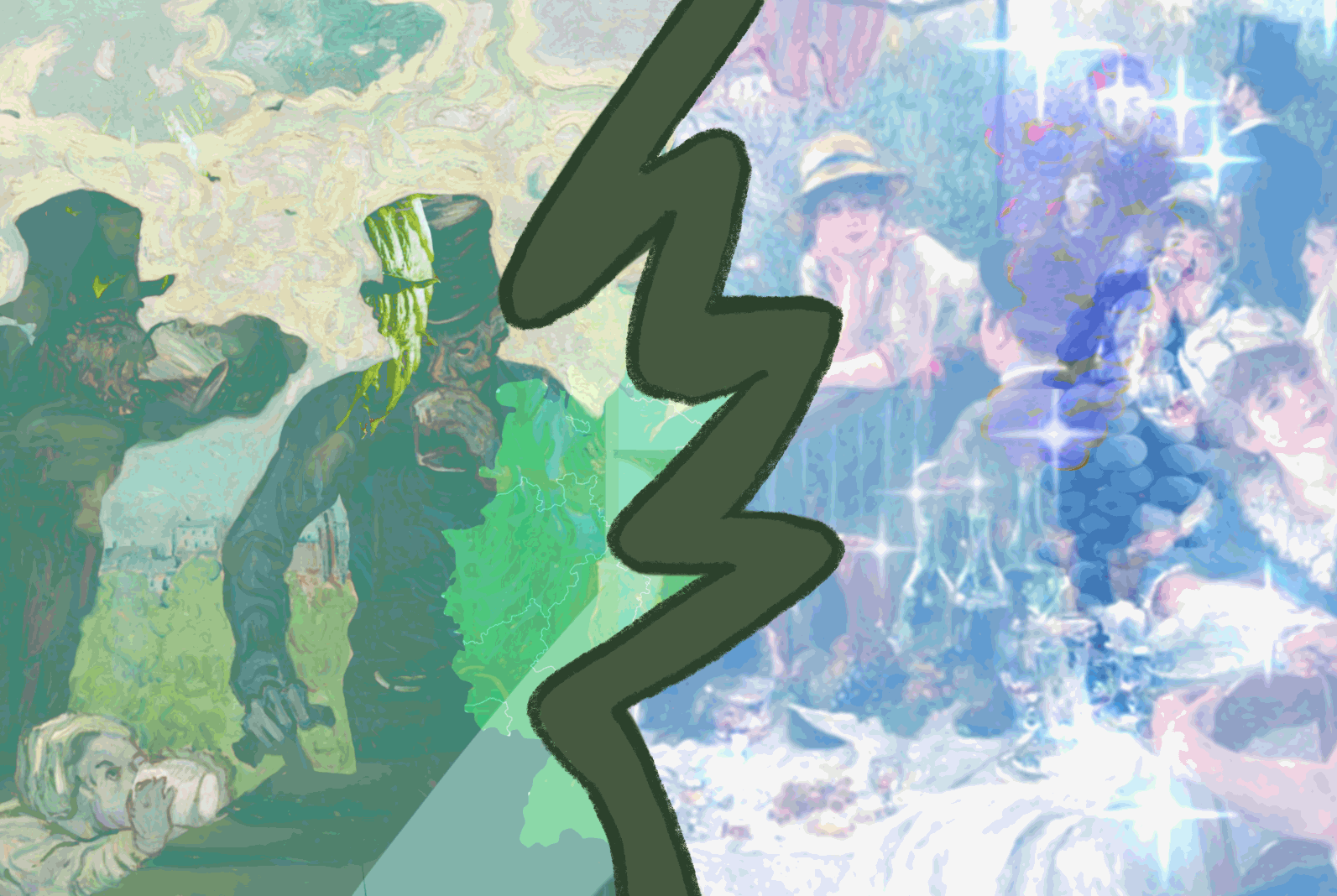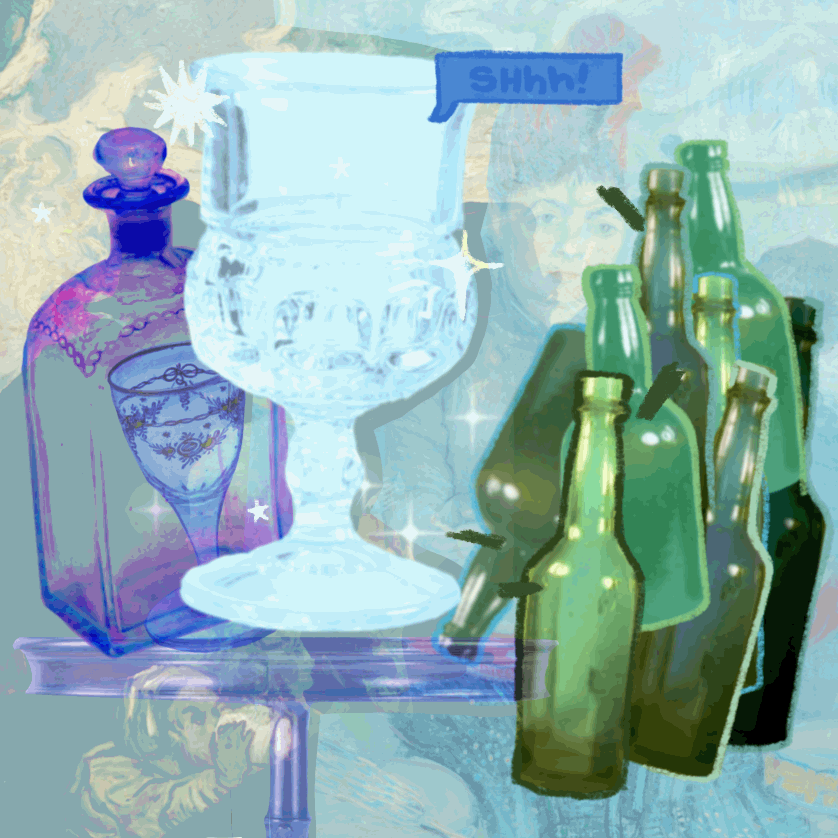One day last spring, while visiting Paris, I decided to go to the Louvre. Walking through its galleries, I began to notice patterns emerging in the artworks I viewed. One was color: Art made in Italy, France, and Spain glowed with azure waters and skies, figures all bathed in shimmering daylight. Art from Germany, Belgium, and the Netherlands was much more brown—the palettes deeper, the nights longer. England—my home—fell strongly into the latter camp.
Soon, I noticed another theme. In those Southern European works, I saw glasses of red wine held aloft and clinked by beautiful women and holy men. But in Northern European paintings, wine was scarce—instead, there was beer, hoisted in heavy vessels, and accompanying frolicking, half-cut figures.
As an art critic, my first point of reference for cultural phenomena is always the artworks themselves, which are some of our most valuable first-person accounts of history. Observing those pictorial patterns led me to wonder: Is there a clear-cut distinction between wine- and beer-drinking Europe, and if so, how is that captured in art? And if it’s not so geographically clear-cut, what do wine and beer signpost about the figures drinking them in general?
I’m not the only one who’s observed those visual patterns. In his documentary “Magnetic North,” historian Jonathan Meades described a neat way to categorize the cultures of Europe—even neater than by religious histories or geographical borders—which he termed “The Hop/Vine Divide.” That divide is a vague geographical border that runs through Europe, roughly splitting France in two before continuing eastwards. It separates the southern regions, whose society and appetites are supported by healthy viticulture, and the northern states where, as Meades put it, “the weather’s not up to it.”
As Meades envisions it, the Hop/Vine Divide snakes through the continent on the flatlands, symbolically separating not just whether beer or wine is the preferred drink, but also seemingly stark differences in cultural and religious identities.
“The lands of Northern Europe, where grapevines cease to grow, and where grain-growing is central to its societies’ palates and industry, are beer-favoring nations. Below the border, in Southern Europe, viticulture dominates. And this is reflected in the artwork of these regions, from the Middle Ages right through to Modernism.”
These culinary preferences have been put down to the dichotomy between so-called “Roman” (Southern European, Italian) and “Barbarian” (Northern European, Germanic) cultures, as put by Italian historian Massimo Montanari, that met, mingled, and fought in Europe for hundreds of years following the first expansions of the Roman Empire in the 1st century AD. The anthropologist F. Xavier Medina put it succinctly in his contribution to “Liquid Bread,” a multidisciplinary look at brewing processes and beer’s role in societies both ancient and modern: “From the Middle Ages onward … a new definition of a European food model was invented from the confluence of Roman and Germanic cultures. These were initially different and even contrasting: field versus forest; cereal, vine, and olive agriculture versus hunting and animal husbandry. The culture of bread, wine and olive oil against the culture of meat, beer, and butter.”
The lands of Northern Europe, where grapevines cease to grow, and where grain-growing is central to its societies’ palates and industry, are beer-favoring nations. Below the border, in Southern Europe, viticulture dominates. And this is reflected in the artwork of these regions, from the Middle Ages right through to Modernism.
One painting that captures the stereotypical qualities of the beer-drinking image—marked by excessive consumption and by associations with the working class—is Vincent van Gogh’s 1887 painting, “In the Café: Agostina Segatori in Le Tambourin.” Although depicting the interior of a Parisian cafe (a city which hovers on the edge of Hop/Vine Divide), the painting shows several elements that are typical of European beer-drinking scenes. Segatori, the owner of the café, sits alone. This is not her first drink (the pile of glass coasters, which would be served one-per-glass, give this away), and her behavior—sat slumped, with a raucous hairdo, and smoking a cigarette—signals that she is not considered a refined, upstanding woman in society.
In Diego Velázquez’s 1628 painting “The Triumph of Bacchus” (also known as “Los Borrachos,” or “The Drinkers”), by contrast, we see a dainty wine glass held aloft in the background. This painting could be considered an emblem of the wine-drinking image: Wine is consumed as a social activity, and even amidst over-consumption—hinted at by the drinkers’ flushed faces and eager expressions—the depiction is elevated, evoking classical history and iconography.
Another example of the wine-drinking image—where consumption is framed as a socially sanctioned activity among the middle and upper classes, part of religious or domestic ritual—is Johannes Vermeer’s 1658 painting, “The Glass of Wine” Here, the act of drinking is an elegant one, with a socially acceptable distance kept between the male and female figures, and a symbol of temperance and emotional restraint captured in the details of the stained glass window, which shows a woman holding a level and bridle, making literal the moral goal of control and steadfastness.
But as neat and appealing as this thesis of clear division is, cracks begin to show when you look too closely at the Hop/Vine Divide (Vermeer, for instance, is a Northern artist). What looks like a neat, easy line shows itself to be a false dichotomy—especially in a modernizing Europe in which beer, wine, and artists themselves begin to travel more freely across the continent.
Beer’s association with drinking to excess (as opposed to wine’s association with being drunk to nourish the soul, which we’ll explore next) can be seen in the work of several great Northern artists.
In Pieter Bruegel the Elder’s “Peasant Wedding” from 1567, we have a painting so busy you can almost hear it. Beer is flowing in this Flanders wedding, and in the bottom left corner we can see the aplomb with which it is poured. The crowded scene is bustling, and revelers almost spill their plates of food while crowds push their way into the barn. A mother in the background sitting next to her child raises her mug to be refilled.
Following the Protestant Reformation, new subject matter entered the academy, and for the first time we started to see real people’s lives depicted in art, not just the lives of religious or classical figures. This community is composed of peasant farmers, who likely harvest the grains used to make the beer drunk at the wedding—a wedding which is taking place right on the threshing floor.
Over time, beer drinking in Europe became associated with the lower classes, who were looked down on as intellectually lesser, rowdier, and morally looser, living in remote areas away from centers of culture. Beer had long been associated with the local, the humble, and the domestic; as geographer David Grigg explains, in 18th-century England, beer was “rarely transported more than six miles from a brewery … and because beer in casks deteriorates rapidly, regular deliveries in comparatively small quantities were necessary.”
This coding of beer consumption continued through the centuries. When Pierre-Auguste Renoir was painting his “Dances” series in the early 1880s, his depiction of “Dance in the City,” which shows a bourgeois couple at a formal dance, is in stark contrast with “Dance at Bougival,” which takes place in a village around 10 miles from Paris. In “Dance at Bougival,” the couple dance with much more vigor on the dirt road, and half-finished beer glasses litter the table behind them. Beer is also linked to the frivolity of laboring folk in van Gogh’s 1890 work “The Drinkers.” His subjects take their drinks outside, and the loose marks made by the artist seem to reflect a swaying movement of the drunken laborers.
“In Pieter Bruegel the Elder’s ‘Peasant Wedding’ from 1567, we have a painting so busy you can almost hear it. Beer is flowing in this Flanders wedding, and in the bottom left corner we can see the aplomb with which it is being poured. The crowded scene is bustling, and revelers almost spill their plates of food while crowds push their way into the barn.”
This stereotype broadens to the harmful notion that fondness of drink—and beer in particular—is an indicator of one’s intellect. It harkens back to the idea of wine’s association with the “Roman”—an empire supposedly built on organization, intellect, and high culture—and beer being “Barbarian”—a supposed destructive force.
In Jan Miense Molenaer’s “The King Drinks” (1648-50) we see the connection between drinking and foolishness. Each of the figures is unsteady in their seat, sat slack-jawed and hunched. The painting captures the Dutch tradition of the “Bean King”: During the Catholic celebration of the Epiphany, groups would wear paper crowns to mimic the Three Wise Men, and whoever found a bean baked into their food was deemed the Bean King, and would be tasked with drinking himself into a stupor for the rest of the day; his fellow revelers needed to raise their cups each time the King drank. This figure was a reference to the Biblical King Herrod, who was often associated with drunkenness.
As Meades describes it, “Beer’s comparatively lowly status may be due to its being predominantly a drink of the North, which does not carry the cliché connotation of silent sybaritism attached to wine”—it would seem that restraint is not in beer’s Northern DNA. There is nothing silent about the scene in “The King Drinks.”
Much of wine’s association with class and restraint can be linked to the power of Southern European empires famed for their artistic cultures, and its significance in the religious ceremonies of those lands. In Michelanelo Caravaggio’s 1602 work “Supper at Emmaus” and Leonardo da Vinci’s “Last Supper,” painted in 1495, wine is seen as an accompaniment to intellectual—and holy—conversation. The moving frontier of Christianity, from the Middle East into Europe via the Roman Empire, “promoted the image” of wine and bread as “symbols of the new faith,” according to Montanari. Wine became not only the drink of the well-heeled, but of the divine.
But the integrity of a strict Hop/Vine Divide through Europe is problematized by the cross-pollination between cultures. When wine first came to the North in a culturally meaningful way, this change was first and foremost adopted by the nobility, fashionable courts, and wealthy individuals. Montanari noted that “although wine conquered the beer-drinking countries, that chiefly regarded the social elite” and in a similar vein, any beer drunk in the South was considered a “drink for the poor” (as explored by anthropologist F. Xavier Medina) and its consumption “increased only during times of economic difficulties and was affected by wine prices.”
Wine’s move to the North was indeed initially a luxury for the wealthy, and its significance as a drink for special occasions continues today. Peder Severin Krøyer’s “Hip, Hip, Hurrah!“ from 1888 captures the enjoyment of wine as part of celebration by the Scandinavian bourgeoisie. In the painting, a happy group radiates joy in the dappled sunlight, all thrilled but not intoxicated. The group consists of the Skagen Painters group, an upper-middle-class social group of affluent Danish painters, as well as their spouses and lovers. The sparkling wine is a celebratory bonus to a pleasant time, as opposed to a foundational aspect of revelry. In Renoir’s 1881 painting “Luncheon of the Boating Party,” a similar sense of politeness and conviviality is captured, despite the quantity of wine being consumed.
Ultimately, the Hop/Vine Divide is less clear-cut in European cultural artifacts than the name suggests. For Medina, the idea of a tangible border “creates in the European imagination two models that are clearly constructed into an opposition which, in most cases, is much less real than is generally assumed.” Wherever the Germanic and Roman cultures met, cultural preferences traveled through the continent. Europe was both Germanic, Roman, both, and neither, its appetites just as multifaceted.
“The moving frontier of Christianity, from the Middle East into Europe via the Roman Empire, ‘promoted the image’ of wine and bread as ‘symbols of the new faith.’ Wine became not only the drink of the well-heeled, but of the divine.”
However, the historical associations and trends of wine- and beer-drinking—practices which were born from economic circumstances, religious connotations, and agricultural limitations of their regions—are still traceable in European artistic output. The Hop/Vine Divide is not as neatly enforceable as it sounds, but art history and cultural artifacts have served to perpetuate Southern and Northern identities which play out in our caricatures of Europe and its countries’ drinks of choice.
Art history is an incomparably useful tool for capturing the cultures of the past and how they have developed into our modern reality. These paintings depict the traditions, habits, and mindsets of Europe, both long-held and in vogue, but ultimately—as said by Montanari—“There are no pure identities. Each is the upshot of contamination, each tradition is a daughter of history—and history never stands still.” The Hop/Vide Divide is less of a border and more of a membrane through which influences and imports pass back and forth.












